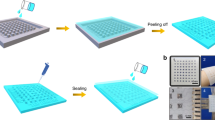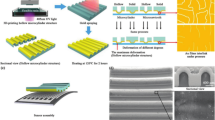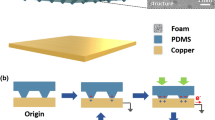Abstract
In this study, a facile and scalable fabrication process of the flexible and transparent tactile sensor array where its operation is based on the triboelectric effect is proposed. The overall process is assisted by the solution based screen printing method, which is well-known as advantageous in the batch fabrication of the electronic devices. The introduction of the batch fabrication process to the tactile sensor array enables the realization of high functionality such as transparency and flexibility. The performance of the fabricated tactile sensor array is systematically investigated through the parametric studies and the discernibility to multiple external physical stimuli such as vertical contact and horizontal sliding is verified. It is confirmed that although the present self-triggered tactile sensor array could be easily fabricated and scaled-up without cumbersome processes, the functionalities such as sensitivity, resolution, transparency, flexibility and even peak power density, are comparable to previously developed tactile sensors. Consequently, the scalable and design-flexible fabrication methodology with cost-effect and high production speed in this study effectively broadens the applicability of the sensor array. As proof-of-concept demonstration of potential applications, a stand-alone sensory lighting system as well as a wearable transparent code generator are developed and their performances are investigated.






Similar content being viewed by others
References
Firouzi, F., Farahani, B., Weinberger, M., DePace, G., & Aliee, F. S. (2020). IoT fundamentals: Definitions, architectures, challenges, and promises. Intelligent Internet of Things. Springer, Cham. p. 3–50. https://doi.org/10.1007/978-3-030-30367-9_1
Al-Garadi, M. A., et al. (2020). A survey of machine and deep learning methods for internet of things (IoT) security. IEEE Communications Surveys & Tutorials, 22(3), 1646–1685.
Ra, Y., et al. (2020). Triboelectric signal generation and its versatile utilization during gear-based ordinary power transmission. Nano Energy, 73, 104745.
Kartsch, V., et al. (2019). An energy-efficient IoT node for HMI applications based on an ultra-low power Multicore Processor. In 2019 IEEE Sensors Applications Symposium (SAS). IEEE.
Alxandre Bissoli., et al. (2019). A human-machine interface based on eye tracking for controlling and monitoring a smart home using the Internet of Things. Sensors, 19(4), 859.
Ryabinin, K., S. Chuprina, & Belousov, K. (2019). Ontology-driven automation of IoT-based human-machine interfaces development. In International Conference on computational science. Springer.
Krupitzer, C., et al. (2020). A survey on human machine interaction in industry. arXiv preprint arXiv:2002.01025.
Cirillo, A., et al. (2017). A distributed tactile sensor for intuitive human-robot interfacing. Journal of Sensors, 2017, 1357061.
Li, T., et al. (2016). Flexible capacitive tactile sensor based on micropatterned dielectric layer. Small, 12(36), 5042–5048.
Ding, W., et al. (2019). Human–machine interfacing enabled by triboelectric nanogenerators and tribotronics. Advanced Materials Technologies, 4(1), 1800487.
Shi, Q., et al. (2019). Minimalist and multi-functional human machine interface (HMI) using a flexible wearable triboelectric patch. Nano Energy, 62, 355–366.
Yang, W., et al. (2014). Triboelectrification based motion sensor for human-machine interfacing. ACS Applied Materials & Interfaces, 6(10), 7479–7484.
Li, S., et al. (2016). All-elastomer-based triboelectric nanogenerator as a keyboard cover to harvest typing energy. ACS nano, 10(8), 7973–7981.
Yao, G., et al. (2019). Bioinspired triboelectric nanogenerators as self‐powered electronic skin for robotic tactile sensing. Advanced Functional Materials, 30(6) 1907312.
Wei, X. Y., et al. (2016). Dynamic triboelectrification-induced electroluminescence and its use in visualized sensing. Advanced Materials, 28(31), 6656–6664.
Wang, X., et al. (2017). Full dynamic-range pressure sensor matrix based on optical and electrical dual-mode sensing. Advanced Materials, 29(15), 1605817.
Wang, X., et al. (2018). A highly stretchable transparent self-powered triboelectric tactile sensor with metallized nanofibers for wearable electronics. Advanced Materials, 30(12), 1706738.
Wang, X., et al. (2016). Self-powered high-resolution and pressure-sensitive triboelectric sensor matrix for real-time tactile mapping. Advanced Materials, 28(15), 2896–2903.
Liu, Y., et al. (2019). Thin, skin-integrated, stretchable triboelectric nanogenerators for tactile sensing. Advanced Electronic Materials, 6(1), 1901174.
Zhao, G., et al. (2019). Transparent and stretchable triboelectric nanogenerator for self-powered tactile sensing. Nano Energy, 59, 302–310.
Jeong, C., et al. (2020). Carbon nanocomposite based mechanical sensing and energy harvesting. International Journal of Precision Engineering and Manufacturing-Green Technology, 7, 247–267.
Lee, D., et al. (2019). A deformable foam-layered triboelectric tactile sensor with adjustable dynamic range. International Journal of Precision Engineering and Manufacturing-Green Technology, 6(1), 43–51.
Oh, Y., et al. (2019). Flexible energy harvester with piezoelectric and thermoelectric hybrid mechanisms for sustainable harvesting. International Journal of Precision Engineering and Manufacturing-Green Technology, 6(4), 691–698.
Yun, Y., et al. (2020). High quality electret based triboelectric nanogenerator for boosted and reliable electrical output performance. International Journal of Precision Engineering and Manufacturing-Green Technology, 1–13. https://doi.org/10.1007/s40684-020-00245-z.
Jang, S., et al. (2019). Optimization of electrospinning parameters for electrospun nanofiber-based triboelectric nanogenerators. International Journal of Precision Engineering and Manufacturing-Green Technology, 6(4), 731–739.
Khalid, S., et al. (2019). A review of human-powered energy harvesting for smart electronics: recent progress and challenges. International Journal of Precision Engineering and Manufacturing-Green Technology, 6, 821–851.
Shahriar, M., Vo, C. P., & Ahn, K. K. (2019). Self-powered flexible PDMS channel assisted discrete liquid column motion based triboelectric nanogenerator (DLC-TENG) as mechanical transducer. International Journal of Precision Engineering and Manufacturing-Green Technology, 6(5), 907–917.
Su, M., Brugger, J., & Kim, B. (2020). Simply structured wearable triboelectric nanogenerator based on a hybrid composition of carbon nanotubes and polymer layer. International Journal Of Precision Engineering And Manufacturing-Green Technology, 7(3), 683–698.
Kim, K., & Yun, K.-S. (2019). Stretchable power-generating sensor array in textile structure using piezoelectric functional threads with hemispherical dome structures. International Journal of Precision Engineering and Manufacturing-Green Technology, 6(4), 699–710.
Zhao, G., et al. (2020). Ultrathin biocompatible electrospun fiber films for self-powered human motion sensor. International Journal of Precision Engineering and Manufacturing-Green Technology, 1–14. https://doi.org/10.1007/s40684-020-00246-y.
Ra, Y., et al. (2020). Cold rolled robust metal assisted triboelectric nanogenerator for extremely durable operation. Extreme Mechanics Letters, 40, 100910.
Wang, G., et al. (2020). A robust stretchable pressure sensor for electronic skins. Organic Electronics, 86, 105926.
Lee, H.-K., Chang, S.-I., & Yoon, E. (2006). A flexible polymer tactile sensor: Fabrication and modular expandability for large area deployment. Journal of microelectromechanical systems, 15(6), 1681–1686.
Wisitsoraat, A., et al. (2007). Low cost thin film based piezoresistive MEMS tactile sensor. Sensors and Actuators A: Physical, 139(1–2), 17–22.
Liu, T., Inoue, Y., & Shibata, K. (2009). A small and low-cost 3-D tactile sensor for a wearable force plate. IEEE Sensors Journal, 9(9), 1103–1110.
Choi, D., et al. (2017). Facile and cost-effective fabrication of patternable superhydrophobic surfaces via salt dissolution assisted etching. Applied Surface Science, 393, 449–456.
Choi, D., Yoo, D., & Kim, D. S. (2015). One-step fabrication of transparent and flexible nanotopographical-triboelectric nanogenerators via thermal nanoimprinting of thermoplastic fluoropolymers. Advanced Materials, 27(45), 7386–7394.
Yoo, D., et al. (2020). Reliable DC voltage generation based on the enhanced performance triboelectric nanogenerator fabricated by nanoimprinting-poling process and an optimized high efficiency integrated circuit. Nano Energy, 69, 104388.
Zhu, G., et al. (2013). Toward large-scale energy harvesting by a nanoparticle-enhanced triboelectric nanogenerator. Nano Letters, 13(2), 847–853.
Kim, Y. D., & Hone, J. (2017). Materials science: Screen printing of 2D semiconductors. Nature, 544(7649), 167–168.
Li, W., Yang, S., & Shamim, A. (2019). Screen printing of silver nanowires: balancing conductivity with transparency while maintaining flexibility and stretchability. npj Flexible Electronics, 3(1), 1–8.
Suikkola, J., et al. (2016). Screen-printing fabrication and characterization of stretchable electronics. Scientific Reports, 6, 25784.
Yoon, H.-J., et al. (2019). 3D-printed biomimetic-villus structure with maximized surface area for triboelectric nanogenerator and dust filter. Nano Energy, 63, 103857.
Choi, S., et al. (2020). Development of a high-performance handheld triboelectric nanogenerator with a lightweight power transmission unit. Advanced Materials Technologies, 5, 2000003.
Choi, J. H., et al. (2019). Development of a triboelectric nanogenerator with enhanced electrical output performance by embedding electrically charged microparticles. Functional Composites and Structures, 1(4), 045005.
Choi, D., et al. (2015). Energy harvesting model of moving water inside a tubular system and its application of a stick-type compact triboelectric nanogenerator. Nano Research, 8(8), 2481–2491.
Chung, J., et al. (2019). Ion-enhanced field emission triboelectric nanogenerator. Advanced Energy Materials, 9(37), 1901731.
Jang, S., et al. (2020). Monocharged electret based liquid-solid interacting triboelectric nanogenerator for its boosted electrical output performance. Nano Energy, 70, 104541.
Choi, D., et al. (2017). A smart pipet tip: triboelectricity and thermoelectricity assisted in situ evaluation of electrolyte concentration. Nano Energy, 38, 419–427.
Cho, H., et al. (2019). Toward sustainable output generation of liquid–solid contact triboelectric nanogenerators: The role of hierarchical structures. Nano Energy, 56, 56–64.
Lin, Z. H., et al. (2013). Water–solid surface contact electrification and its use for harvesting liquid-wave energy. Angewandte Chemie International Edition, 52(48), 12545–12549.
Ra, Y., et al. (2019). Development of a highly transparent and flexible touch sensor based on triboelectric effect. Functional Composites and Structures, 1(4), 045001.
Yang, Y., et al. (2013). Human skin based triboelectric nanogenerators for harvesting biomechanical energy and as self-powered active tactile sensor system. ACS Nano, 7(10), 9213–9222.
Seung, W., et al. (2015). Nanopatterned textile-based wearable triboelectric nanogenerator. ACS Nano, 9(4), 3501–3509.
Zhang, H., et al. (2014). Triboelectric nanogenerator for harvesting vibration energy in full space and as self-powered acceleration sensor. Advanced Functional Materials, 24(10), 1401–1407.
Park, H. R., et al. (2020). Arrangement optimization of water-driven triboelectric nanogenerators considering capillary phenomenon between hydrophobic surfaces. Scientific Reports, 10(1), 1–8.
Yoo, D., et al. (2019). Biomimetic anti-reflective triboelectric nanogenerator for concurrent harvesting of solar and raindrop energies. Nano Energy, 57, 424–431.
Lin, Z. H., et al. (2014). Harvesting water drop energy by a sequential contact-electrification and electrostatic-induction process. Advanced Materials, 26(27), 4690–4696.
Kim, J., et al. (2020). High permittivity CaCu3Ti4O12 particle-induced internal polarization amplification for high performance triboelectric nanogenerators. Advanced Energy Materials, 10(9), 1903524.
Yoo, D., et al. (2019). Increased interfacial area between dielectric layer and electrode of triboelectric nanogenerator toward robustness and boosted energy output. Nanomaterials, 9(1), 71.
Choi, D., et al. (2013). Spontaneous electrical charging of droplets by conventional pipetting. Scientific Reports, 3, 2037.
Choi, D., et al. (2017). Spontaneous occurrence of liquid-solid contact electrification in nature: Toward a robust triboelectric nanogenerator inspired by the natural lotus leaf. Nano Energy, 36, 250–259.
Cho, S., et al. (2020). Universal biomechanical energy harvesting from joint movements using a direction-switchable triboelectric nanogenerator. Nano Energy, 71, 104584.
Chung, J., et al. (2020). Versatile surface for solid–solid/liquid–solid triboelectric nanogenerator based on fluorocarbon liquid infused surfaces. Science and Technology of Advanced Materials, 21(1), 139–146.
Cheng, Y., et al. (2019). Highly stretchable triboelectric tactile sensor for electronic skin. Nano Energy, 64, 103907.
Li, T., et al. (2017). From dual-mode triboelectric nanogenerator to smart tactile sensor: a multiplexing design. ACS nano, 11(4), 3950–3956.
Liu, S., et al. (2019). Triboelectric nanogenerators enabled sensing and actuation for robotics. Nano Energy, 65, 104005.
Tao, J., et al. (2019). Self-powered tactile sensor array systems based on the triboelectric effect. Advanced Functional Materials, 29(41), 1806379.
Liang, X., et al. (2019). Highly transparent triboelectric nanogenerator utilizing in-situ chemically welded silver nanowire network as electrode for mechanical energy harvesting and body motion monitoring. Nano Energy, 59, 508–516.
Fan, F. R., et al. (2014). Highly transparent and flexible triboelectric nanogenerators: performance improvements and fundamental mechanisms. Journal of Materials Chemistry A, 2(33), 13219–13225.
Pu, X., et al. (2017). Ultrastretchable, transparent triboelectric nanogenerator as electronic skin for biomechanical energy harvesting and tactile sensing. Science Advances, 3(5), e1700015.
Wang, Z. L., & Wang, A. C. (2019). On the origin of contact-electrification. Materials Today, 30, 34–51.
Kim, K., et al. (2017). Multifunctional woven structure operating as triboelectric energy harvester, capacitive tactile sensor array, and piezoresistive strain sensor array. Sensors, 17(11), 2582.
Acknowledgements
This work was supported by the National Research Foundation of Korea (NRF) grant funded by the Korea government (MSIT) (No. NRF-2019R1C1C1005846). S. J. P. was supported by Basic Research Program through the National Research Foundation of Korea (NRF) funded by the Ministry of Education (2018R1A6A1A03025526).
Author information
Authors and Affiliations
Corresponding authors
Ethics declarations
Conflict of Interest
On behalf of all authors, Dongwhi Choi states that there is no conflict of interest.
Additional information
Publisher's Note
Springer Nature remains neutral with regard to jurisdictional claims in published maps and institutional affiliations.
Electronic supplementary material
Below is the link to the electronic supplementary material.
Supplementary material 1 (MP4 52484 kb)
Rights and permissions
About this article
Cite this article
Ra, Y., La, M., Cho, S. et al. Scalable Batch Fabrication of Flexible, Transparent and Self-triggered Tactile Sensor Array Based on Triboelectric Effect. Int. J. of Precis. Eng. and Manuf.-Green Tech. 8, 519–531 (2021). https://doi.org/10.1007/s40684-020-00267-7
Received:
Revised:
Accepted:
Published:
Issue Date:
DOI: https://doi.org/10.1007/s40684-020-00267-7




